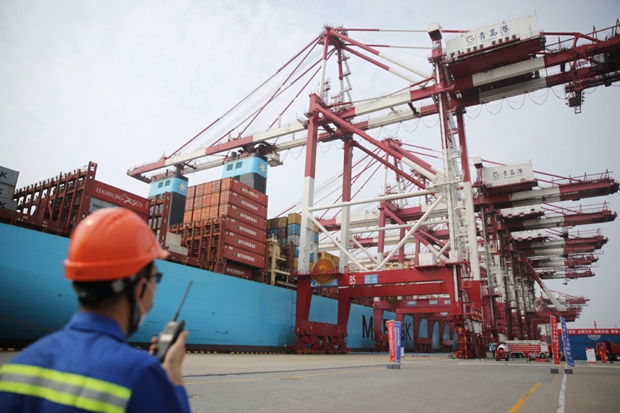Shandong, ASEAN strengthen ties
(chinadaily.com.cn)| Updated : 2020-09-16
Print Print
An employee inspects cargo handling equipment at a container terminal in the China (Shandong) Pilot Free Trade Zone in Qingdao, Shandong province. [Photo by Zhang Jingang/For China Daily]
East China's Shandong province has launched a slew of measures and preferential policies to create a world-class business environment and optimize its industrial structure in an effort to attract more high-quality foreign investment.
With the 10-member Association of Southeast Asian Nations becoming Shandong's largest trading partner and export market in the first half of the year, the two sides are enjoying stronger trade ties.
Official data showed that four Fortune Global 500 companies based in ASEAN have invested in a total of 41 projects in Shandong.
Imports and exports between the two regions were valued at 123.47 billion yuan ($18.19 billion) in the first six months, up 16 percent year-on-year.
An online meeting for foreign-funded projects was held in Jinan, capital of Shandong, on Feb 25, 2020, during which agreements for 66 projects worth $4.27 billion were signed.
One such project is the construction of a supply chain center for Tee Yih Jia, a food manufacturing company headquartered in Singapore. It will cost an estimated $200 million and be built in the Qingdao Area of the China (Shandong) Pilot Free Trade Zone.
It is meant to serve as a regional base for high-quality imported food, meat, fruit, and vegetable products, as well as a global FMCG (fast moving consumer goods) display and experience center for the entire country.
Tee Yih Jia, founded in 1977, is an export-oriented Asian frozen food manufacturer with world-class production facilities in Singapore, China, Malaysia, and the USA.
The establishment of the China (Shandong) Pilot Free Trade Zone has contributed significantly to the development of Shandong.
Covering a total area of 119.98 square kilometers, the Shandong FTZ is designed to boost national trade, facilitate opening-up, and boost high-quality development through reforms.

 Xi's Moments
Xi's Moments  Shandong gains remarkable results in promoting high-quality development
Shandong gains remarkable results in promoting high-quality development  Discover magnolia blossoms at Shandong University
Discover magnolia blossoms at Shandong University